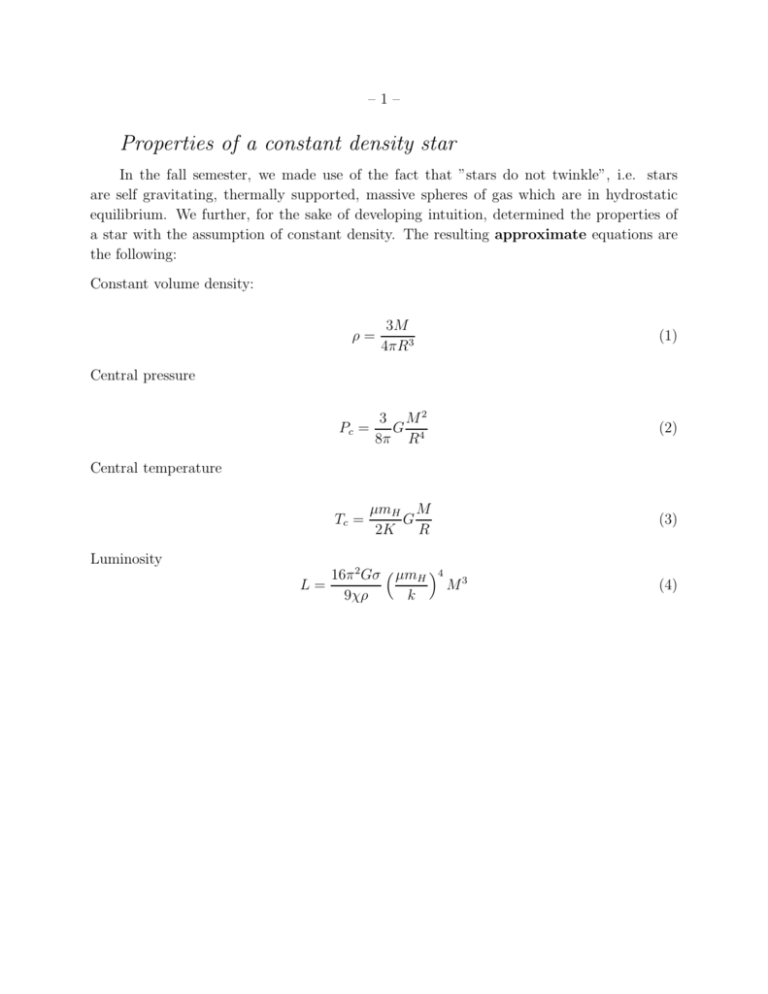Lecture 1
advertisement

–1– Properties of a constant density star In the fall semester, we made use of the fact that ”stars do not twinkle”, i.e. stars are self gravitating, thermally supported, massive spheres of gas which are in hydrostatic equilibrium. We further, for the sake of developing intuition, determined the properties of a star with the assumption of constant density. The resulting approximate equations are the following: Constant volume density: 3M 4πR3 (1) 3 M2 G 8π R4 (2) µmH M G 2K R (3) 16π 2 Gσ µmH 4 3 M 9χρ k (4) ρ= Central pressure Pc = Central temperature Tc = Luminosity L= –2– Pre-Main Sequence Evolution In the pre-main sequence phase, the star is powered by the liberation of gravitational potential energy through the slow, quasistatic contraction of the star. This can be seen by using the constant density approximation. The gravitational potential energy for a constant density star is: U =− 3 GM 2 5 R (5) Then assuming virial equilibrium and assuming thermal gas pressure: 1 W = U 2 (6) The luminosity can be then be related to the change in radius: L= dW 3 GM 2 dR =− dt 10 R2 dt (7) We can also plot pre-main sequence evolution in terms of Tc vs Pc M T = 4.1 × 10 µ M⊙ 6 23 1 ρ− 3 (8) For stars with masses in excess of 5.5 M⊙ where radiation pressure dominates. T = 1.92 × 10 7 M M⊙ 16 1 ρ− 3 (9) As the star contracts, the density and temperature rises until the onset of nuclear fusion at central temperatures of 107 K. At this point, the star becomes a main sequence star. –3– There are three major timescales in stellar evolution: The free fall time is the time for which a gas cloud collapse onto a protostars (this is really the lower limit, since it assumes no pressure, just gravity): tf f = 3π 32Gρ 21 (10) For a density of 104 H2 molecules cm−3 and assuming a 9% He/H ratio by number, we get a volume density of 4.5x10−20 cm−3 and a free fall time of 300,000 years. The Kelvin-Helmholtz time is the duration over which a star can produce luminosity through quasistatic contraction (i.e. the pre-main sequence phase). GM 2 tKH = RL For a M = 1 M⊙ , R=2 R⊙ and, L = 5 L⊙ , tKH = 30 × 106 years. (11) The nuclear time is the duration over which a star contain sustain itself by fusion of Hydrogen atoms. This is given by: tnuc = 10−3 Mc2 L For a star with M = 1 M⊙ and L = 1 L⊙ , then tnuc = 107 years. (12) –4– Free-Fall timescale: collapse time for a molecular cloud. We begin by assuming a constant density sphere with an initial density ρ0 and initial radius of r0 . We also assume that initially the sphere is at rest. If we further assume that there is not pressure, Newton’s Laws give us: GM G4πρ0 r03 d2 r = − = − dt2 R2 3r 2 (13) To solve this equation, we multiply each side by dr/dt and integrate. dr d2 r G4πρ0 r03 dr = − dt dt2 3r 2 dt dr dt d(r/r0 ) dt 2 2 d(r/r0) =− dt = (14) G8πρ0 r03 3r (15) G8πρ0 r0 −1 = 3 r G8πρ0 3 12 12 r0 −1 r (16) (17) Note that we have adopted the root of the equation where dr/dt will be negative, which is what we expect. We now substitute r/r0 = cos2 (β) and then integrate by β on the left size and t on the right size. 1 G8πρ0 2 sin(β) dβ =− −2cos(β)sin(β) dt 3 cos(β) (18) Using standard trig identities we find: 2 2cos (β)dβ = 1 + cos(2β)dβ = G8πρ0 3 12 G8πρ0 3 dt 12 dt (19) (20) –5– Integrating these from t = 0 to t and β = 0 to β we get: 1 β + sin(2β) = 2 G8πρ0 3 12 t (21) Now during the collapse, r goes from r0 to 0 and β accordingly goes from 0 to π/2. Thus, we solve for t when β = π/2 π = 2 G8πρ0 3 12 tf f (22) which has the solution: tf f = 3π 32Gρ0 21 (23) A pecuilliar aspect of this solution is that gas at every initial radius collapses to the center at the same time. Kelvin-Helmoltz timescale: duration over which energy can be derived from gravity Total gravitational energy: U ∼ − GM R 2 2 (or U = − 35 GM for a constant density sphere) R Kelvin-Helmholz time scale is thus tKH U GM 2 = = L RL Nuclear Timescale: duration of Hydrogen burning Energy produced per baryon by P − P chain or CNO cycle: ∼ 6.5MeV . Mass of a nucleon (1 A.M.U.) : 930 MeV (24) –6– Thus, about 0.7% of the mass per nucleon is converted to energy. Since only the central ∼ 10% of the mass of a star is hot and dense enough for nuclear fusion, only about ∼ 0.1% of the stellar mass can be converted into energy. Spectral Energy Distributions Spectral energy distribution are composite spectra assembled from broad-band photometry and spectra with the goal of spanning a wavelength range covering several orders of magnitude. Often plotted as log(λ) vs λFλ where Fλ is the flux density per wavelength (Energy per time per area per unit wavelength). The Spectral Index is defined as α= dlog(λFλ) dlog(λ) Note that for a alpha = 0, i.e. a flat spectrum source, For young stellar objects • α > 0.3 is a Class I source • −0.3 < α < 0.3 is a flat spectrum source • −3 < α < −0.3 is a Class II • α = −3 is a Class III object (pure photosphere) (25)







